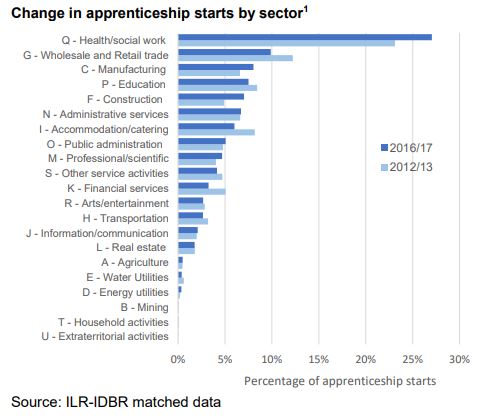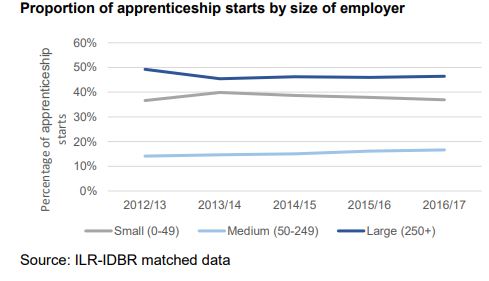New research on apprenticeships by industry characteristics has revealed which sector is the most popular, what is preferred by each gender and where in the country apprenticeship starts are lowest.
The Department for Education has compiled statistics focusing on the five academic years between 2012/13 and 2016/17, and published them today.
Here are five things that we learnt.
1. Health and social work dominates
The data shows that health and social work is clearly the most popular sector for apprentices, making up 27 per cent (121,680) of all starts in 2016/17, up from 23 per cent (104,170) in 2012/13. It was also the most popular for higher apprenticeships, making up 43 per cent of all higher apprenticeship starts in 2016/17.
The manufacturing and construction sectors also saw slight increases in apprenticeship starts over the five years, but the biggest drops were seen in wholesale and retail trade, accommodation and catering and financial services.

2. Fewest people are beginning apprenticeships in the north east
The north east had the smallest number (29,770) of apprenticeships in 2016/17, making up just seven per cent of starts. But interestingly, the north west had the highest proportion, with 16 per cent (70,220) of all apprenticeship starts coming from that region.
Across all regions, health and social work was the most popular sector for apprentices, and starts in wholesale and retail trade declined.
3. Women choose social work, men choose construction
The data also shows that traditional ideas of gender roles are still holding strong among apprenticeships. In 2016/17, 88 per cent of all starts in the construction sector were by men, and construction, manufacturing and wholesale and retail trade between them accounted for 40 per cent of all male apprenticeship starts.
In comparison, 85 per cent of all starts in the health and social work sector were women, which accounted for 43 per cent of all female starts.
Since 2012/13, the number of female apprenticeship starts have dropped from 244,380 to 238,290, but men have increased from 205,880 to 211,530.
4. Large employers make up the majority of starts
Although large employers (those with 250 or more employees) made up just nine per cent of all employers with apprenticeship starts in 2016-17, 46 per cent of all apprenticeship starts were at large employers. This is a decrease of three per cent from 2012/13.
Small employers (less than 50 employees) took on 37 per cent of apprenticeship starts, with medium sized employers (50-249 employees) the least likely to have an apprentice, taking on just 17 per cent.

5. Differences by age
Heath and social work is more likely to be dominated by older apprentices, with 66 per cent of its starts being from those aged 25 and over in 2016-17.
The youngest apprentices, under 19s, made up over half (54 per cent) of those in the ‘other services’ sector, while 42 per cent of starts in public administration and defence were from apprentices aged between 19 and 24.








The regional information above is not interpretted in context and is therefore too crude to be helpful. Per capita would have been much more helpful and would have shown that London, East and South East have starts falling below their regional population volumes. (London is 16% of Eng population but only 10% of app starts!!) The NE is above – 5% of England population but accoutns for 7% of starts. Minimal diff between NE and NW performance once adjusted.